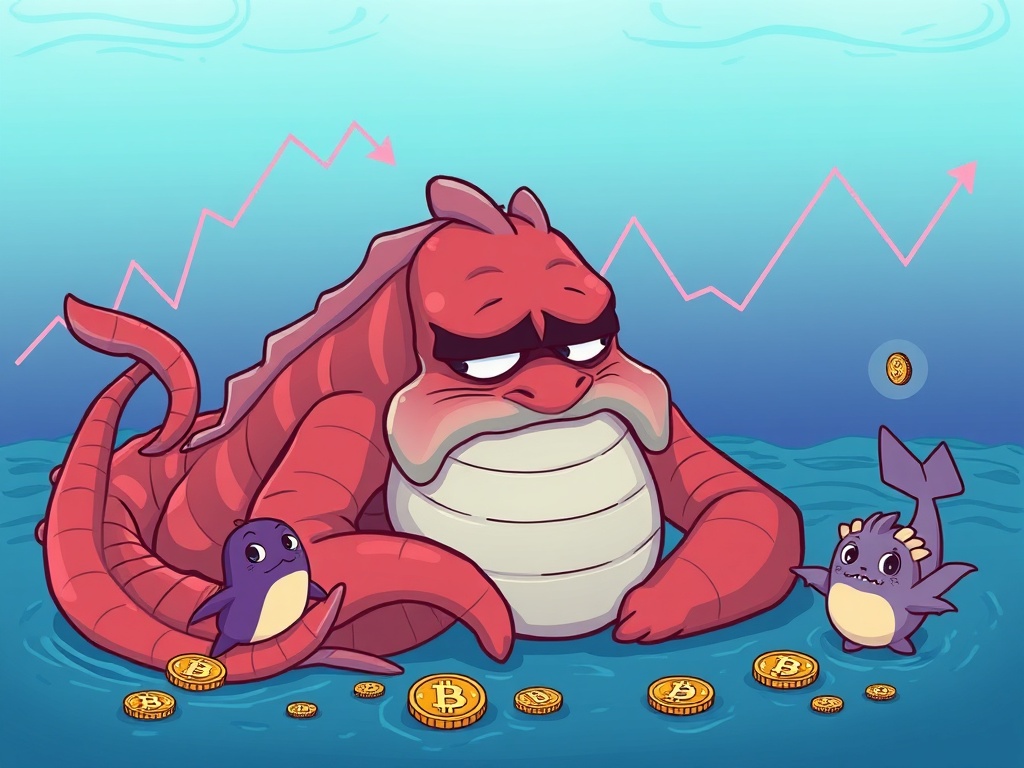BitcoinWorld

Kraken Revenue Plummets: A Crucial Look at Q2 Declines
The cryptocurrency market is no stranger to volatility, but recent reports indicate a significant shift for one of its long-standing pillars. American crypto exchange Kraken revenue experienced a notable decline in its Q2 performance, signaling a challenging period for the industry giant. This downturn, as reported by DL News, highlights the intense pressures faced by centralized exchanges amid fierce competition and a contracting trading landscape. What does this mean for Kraken, its users, and the broader digital asset ecosystem?
Understanding the Drop in Kraken Revenue
Kraken, a prominent player in the crypto exchange arena, saw its Q2 revenue drop to $411 million. This figure represents a 13% decrease from the previous quarter’s performance, where revenue stood at a healthier $473 million. The financial downturn was directly correlated with a significant dip in trading volume, a crucial metric for any exchange’s profitability.
- Q1 Trading Volume: $208 billion
- Q2 Trading Volume: $186 billion
This decline of $22 billion in trading volume paints a clear picture: fewer transactions are occurring on the platform, directly impacting the fees Kraken earns. While a 13% quarterly decrease might seem manageable, it signals a trend that warrants closer examination, especially for a company operating in a sector known for its rapid shifts.
Why Did Kraken Revenue Plummet? Unpacking the Core Challenges
The reasons behind Kraken’s Q2 revenue dip are multifaceted, reflecting both company-specific dynamics and broader market headwinds. Two primary factors stand out: intense competition and a significant decline in overall trading volume across the cryptocurrency market.
1. Fierce Competition in the Crypto Exchange Landscape
The cryptocurrency exchange market is arguably one of the most competitive financial sectors globally. Hundreds of platforms vie for user attention, offering varying fee structures, token selections, and unique features. Kraken, despite its established reputation, faces relentless pressure from multiple angles:
- Global Giants: Exchanges like Binance and Coinbase continue to dominate market share, leveraging vast user bases, extensive marketing budgets, and diversified product offerings. Their ability to onboard new users and offer a wide array of services puts constant pressure on competitors.
- Emerging Challengers: Newer platforms often enter the market with innovative features, aggressive promotional campaigns, or specialized niches (e.g., DeFi-focused exchanges, derivatives platforms). These nimble players can quickly capture market segments.
- Decentralized Alternatives (DEXs): The rise of Decentralized Exchanges (DEXs) like Uniswap and PancakeSwap offers users an alternative to centralized platforms, appealing to those who prioritize self-custody and censorship resistance. While their trading volumes might not directly compete dollar-for-dollar with CEXs in all areas, they siphon off a segment of the market that might otherwise use platforms like Kraken.
- Traditional Finance (TradFi) Entrants: As institutional interest in crypto grows, traditional financial powerhouses are increasingly launching their own crypto services or acquiring existing players. This brings immense capital, regulatory expertise, and established client networks into the fray, intensifying the competition for institutional flows.
This fragmented and highly competitive environment means that even well-established exchanges like Kraken must constantly innovate and adapt to retain their user base and attract new traders.
2. Declining Trading Volume: A Market-Wide Phenomenon
Beyond competition, the most significant contributor to the decline in Kraken revenue is the broader contraction in cryptocurrency trading volumes. Q2 2023 was characterized by a continuation of the bear market sentiment that began in 2022, albeit with some periods of consolidation. Several factors contributed to this market-wide slowdown:
- Macroeconomic Headwinds: High inflation, rising interest rates, and concerns about a potential global recession have led investors to reduce their exposure to riskier assets like cryptocurrencies. Capital flows tend to shift towards safer havens during periods of economic uncertainty.
- Regulatory Uncertainty: The regulatory landscape for cryptocurrencies remains fragmented and often unpredictable across different jurisdictions. Increased scrutiny from bodies like the SEC in the US, coupled with enforcement actions against various crypto entities, has created an environment of caution, leading some institutional and retail investors to pull back.
- Reduced Retail Participation: The excitement and speculative fervor that characterized the 2021 bull run have largely subsided. Retail investors, who form a significant portion of trading volume, are less active, preferring to hold or exit positions rather than engage in frequent trading.
- Lower Volatility: While crypto is known for volatility, there have been periods of reduced price action in Q2 compared to previous quarters, particularly for major assets like Bitcoin and Ethereum. Lower volatility often translates to fewer trading opportunities and thus lower trading volumes.
These macroeconomic and market-specific factors collectively created a challenging environment for all crypto exchanges, and Kraken was not immune to their impact.
Beyond the Numbers: Implications for Kraken’s Future and the Crypto Market
The decline in Kraken revenue is more than just a quarterly financial blip; it carries significant implications for the exchange’s strategic direction and offers insights into the evolving state of the broader crypto market.
What Does This Mean for Kraken?
For Kraken, a decrease in revenue and trading volume necessitates a strategic re-evaluation. Potential implications include:
- Cost Optimization: Exchanges often respond to revenue declines by scrutinizing operational costs, which can include hiring freezes, layoffs, or a re-prioritization of development projects.
- Product Diversification: To offset reliance on spot trading fees, Kraken might accelerate efforts to diversify its revenue streams. This could involve expanding its offerings in staking, derivatives, lending, or even exploring non-exchange related services like NFTs or Web3 infrastructure.
- Enhanced User Experience: In a competitive market, retaining existing users and attracting new ones becomes paramount. Investing in a more intuitive user interface, robust customer support, and enhanced security features can be crucial.
- Regulatory Compliance Focus: With increasing regulatory pressure, exchanges must invest heavily in compliance frameworks. While this is a cost, it also offers a competitive advantage by building trust and potentially opening doors to new markets.
Broader Market Health and Outlook
Kraken’s situation is indicative of a broader trend within the centralized crypto exchange sector. Many exchanges have reported similar declines in trading volumes and revenue throughout 2023. This suggests:
- Market Maturation: The “wild west” days of crypto are slowly giving way to a more mature, albeit still volatile, financial market. This maturation often brings lower speculative trading and more fundamental, long-term investment.
- Consolidation: Smaller, less capitalized exchanges may struggle to survive in this environment, potentially leading to industry consolidation. Larger, more resilient players like Kraken are better positioned to weather the storm.
- Shift in Focus: The industry might shift its focus from purely speculative trading to utility-driven applications of blockchain technology, such as real-world asset tokenization, decentralized identity, and enterprise solutions.
Navigating the Storm: Strategies for Crypto Exchanges to Thrive
In a challenging market, survival and growth depend on strategic adaptation. Crypto exchanges, including Kraken, can implement several key strategies to navigate revenue declines and position themselves for future success:
1. Diversify Revenue Streams Beyond Spot Trading
Over-reliance on spot trading fees makes exchanges highly vulnerable to market downturns. Diversification is key:
- Staking Services: Offer users the ability to stake their cryptocurrencies to earn rewards, generating a share of the staking yield for the exchange.
- Derivatives Trading: Provide options for futures, options, and perpetual swaps, which can attract sophisticated traders and generate fees even in sideways markets.
- Lending & Borrowing: Facilitate crypto lending and borrowing, earning interest on loans.
- Institutional Services: Develop tailored solutions for institutional clients, including OTC desks, prime brokerage services, and bespoke custody solutions, which often involve higher volume and more stable revenue.
- NFT Marketplaces & Web3 Gaming: Explore integrating or launching services related to non-fungible tokens (NFTs) and blockchain gaming, tapping into new growth areas.
2. Prioritize Regulatory Compliance and Trust Building
In an era of heightened scrutiny, robust compliance is not just a necessity but a competitive advantage. Exchanges that proactively engage with regulators and build transparent, secure platforms will earn user trust:
- Obtain Licenses: Actively pursue regulatory licenses in key jurisdictions to operate legally and build credibility.
- Enhanced Security: Implement state-of-the-art security measures to protect user assets and data, crucial after high-profile exchange collapses.
- Transparent Communication: Maintain open and honest communication with users about platform status, security protocols, and market conditions.
3. Enhance User Experience and Product Innovation
A superior user experience can be a powerful differentiator, attracting and retaining users even when trading volumes are low:
- Intuitive UI/UX: Design platforms that are easy to navigate for both beginners and advanced traders.
- Customer Support: Provide responsive and effective customer service to resolve issues quickly.
- New Asset Listings: Carefully vet and list promising new cryptocurrencies and tokens to keep the platform fresh and attractive.
- Educational Resources: Offer educational content to help users understand crypto and make informed decisions, fostering a loyal community.
A Look Ahead: What’s Next for Kraken?
Despite the recent dip in Kraken revenue, the exchange remains a significant player with a strong brand reputation, particularly known for its security and commitment to regulatory compliance. While the short-term outlook for centralized exchanges remains challenging due to ongoing market volatility and regulatory headwinds, Kraken’s long-term trajectory will depend on its ability to adapt.
Successful navigation of this period will likely involve a continued focus on core strengths, strategic diversification of offerings, and an unwavering commitment to user trust and regulatory adherence. As the crypto market evolves, so too must its foundational institutions. Kraken’s response to these challenges will be a crucial indicator of its resilience and future success in the dynamic world of digital assets.
In conclusion, Kraken’s Q2 revenue decline is a stark reminder of the volatile and competitive nature of the cryptocurrency exchange market. Driven by fierce competition and a broad market downturn, this dip underscores the need for strategic adaptation. For Kraken and other exchanges, the path forward involves diversifying revenue streams, prioritizing robust regulatory compliance, and relentlessly innovating to enhance the user experience. While the immediate future presents hurdles, these challenges also offer an opportunity for the industry to mature and build a more resilient foundation for the next wave of crypto adoption. The insights gained from Kraken’s experience are crucial for anyone looking to understand the intricate dynamics of today’s digital asset landscape.
Frequently Asked Questions (FAQs)
Q1: What caused Kraken’s Q2 revenue decline?
A1: Kraken’s Q2 revenue decline was primarily caused by fierce competition within the crypto exchange market and a significant drop in overall cryptocurrency trading volumes across the industry, influenced by macroeconomic factors and regulatory uncertainty.
Q2: How much did Kraken’s revenue decrease in Q2?
A2: Kraken’s Q2 revenue decreased by 13% from the previous quarter, falling to $411 million from $473 million in Q1.
Q3: What was the impact on Kraken’s trading volume?
A3: Kraken’s trading volume also fell from $208 billion in Q1 to $186 billion in Q2, directly contributing to the revenue decline.
Q4: How can crypto exchanges like Kraken mitigate such declines?
A4: Exchanges can mitigate declines by diversifying revenue streams (e.g., staking, derivatives, institutional services), prioritizing robust regulatory compliance, enhancing user experience, and continuously innovating their product offerings.
Q5: Does this decline indicate a bearish trend for the entire crypto market?
A5: While Kraken’s decline reflects broader market challenges like reduced trading volumes and regulatory uncertainty, it’s more indicative of the maturation and consolidation within the centralized exchange sector rather than an immediate bearish signal for the entire crypto market, which has diverse segments.
Q6: Is Kraken still a reliable crypto exchange despite the revenue decline?
A6: Yes, Kraken remains a reliable and reputable crypto exchange. Its revenue decline reflects industry-wide challenges, not necessarily a fundamental weakness in its operations or security. Kraken is known for its strong security measures and commitment to regulatory compliance.
Share Your Insights!
Did this article shed light on the challenges facing crypto exchanges? We’d love to hear your thoughts! Share this article on your social media platforms and join the conversation about the future of Kraken and the broader cryptocurrency market. Your engagement helps us continue to provide valuable insights.
To learn more about the latest crypto market trends, explore our article on key developments shaping the crypto market institutional adoption.
This post Kraken Revenue Plummets: A Crucial Look at Q2 Declines first appeared on BitcoinWorld and is written by Editorial Team





